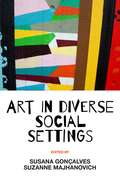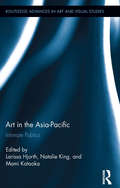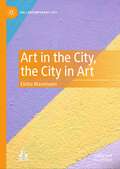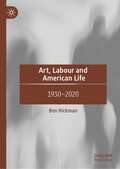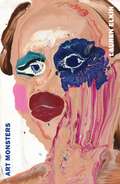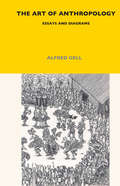- Table View
- List View
Art in Diverse Social Settings
by Susana Gonçalves Suzanne MajhanovichThis edited collection examines the important and multi-varied role that art plays in today's diverse society. Art is linked to the worldviews and mind-sets from which it results and, as a complex and ambiguous product of culture and perception, it can only be truly understood from multiple perspectives. Recognising this, Art in Diverse Social Settings brings together contributions from a diverse range of authors - including scholars and artists from different countries, artistic languages and art statements - to give fresh perspectives on central questions such as: What purpose(s) do the arts serve in contemporary diverse and pluralistic societies? What are the links between art and citizenship in a 'glocal' perspective? Can aesthetics be compared to faith, therapy or civic resistance? Is art a feasible tool to prevent and contest social injustice, raise social consciousness and resistance in the political arena? Can art promote social inclusion? How can artistic practices contribute to community development? The book contains three parts including Part 1 with theoretical chapters, and Parts 2 and 3 that present exemplary case studies illustrating art as a medium for communication and intervention in professional organizations, public spaces and/or the community.
Art in Diverse Social Settings
by Susana Gonçalves Suzanne MajhanovichThis edited collection examines the important and multi-varied role that art plays in today's diverse society. Art is linked to the worldviews and mind-sets from which it results and, as a complex and ambiguous product of culture and perception, it can only be truly understood from multiple perspectives. Recognising this, Art in Diverse Social Settings brings together contributions from a diverse range of authors - including scholars and artists from different countries, artistic languages and art statements - to give fresh perspectives on central questions such as: What purpose(s) do the arts serve in contemporary diverse and pluralistic societies? What are the links between art and citizenship in a 'glocal' perspective? Can aesthetics be compared to faith, therapy or civic resistance? Is art a feasible tool to prevent and contest social injustice, raise social consciousness and resistance in the political arena? Can art promote social inclusion? How can artistic practices contribute to community development? The book contains three parts including Part 1 with theoretical chapters, and Parts 2 and 3 that present exemplary case studies illustrating art as a medium for communication and intervention in professional organizations, public spaces and/or the community.
Art in Science Museums: Towards a Post-Disciplinary Approach (Routledge Research in Museum Studies)
by Camilla Rossi-Linnemann Giulia De MartiniArt in Science Museums brings together perspectives from different practitioners to reflect on the status and meaning of art programmes in science centres and museums around the world.Presenting a balanced mix of theoretical perspectives, practitioners’ reflections, and case-studies, this volume gives voice to a wide range of professionals, from traditional science centres and museums, and from institutions born with the very aim of merging art and science practices. Considering the role of art in the field of science engagement, the book questions whether the arts might help curators to convey complex messages, foster a more open and personal approach to scientific issues, become tools of inclusion, and allow for the production of totally new cultural products. The book also includes a rich collection of projects from all over the world, synthetically presenting cases that reveal very different approaches to the inclusion of art in science programmes.Art in Science Museums should be of great interest to academics, researchers and postgraduate students working in the fields of museum studies, cultural heritage management, material culture, science communication and contemporary art. It should also be essential reading for museum professionals looking to promote more reflective social science engagement in their institutions.
Art in Science Museums: Towards a Post-Disciplinary Approach (Routledge Research in Museum Studies)
by Camilla Rossi-Linnemann Giulia De MartiniArt in Science Museums brings together perspectives from different practitioners to reflect on the status and meaning of art programmes in science centres and museums around the world.Presenting a balanced mix of theoretical perspectives, practitioners’ reflections, and case-studies, this volume gives voice to a wide range of professionals, from traditional science centres and museums, and from institutions born with the very aim of merging art and science practices. Considering the role of art in the field of science engagement, the book questions whether the arts might help curators to convey complex messages, foster a more open and personal approach to scientific issues, become tools of inclusion, and allow for the production of totally new cultural products. The book also includes a rich collection of projects from all over the world, synthetically presenting cases that reveal very different approaches to the inclusion of art in science programmes.Art in Science Museums should be of great interest to academics, researchers and postgraduate students working in the fields of museum studies, cultural heritage management, material culture, science communication and contemporary art. It should also be essential reading for museum professionals looking to promote more reflective social science engagement in their institutions.
Art in Social Work Practice: Theory and Practice: International Perspectives (Routledge Advances in Social Work)
by Ephrat Huss Eltje BosThis is the first book ever to be published on arts use in social work. Bringing together theoretical connections between arts and social work, and with practice examples of arts in micro and macro social work practice from around the world, the book aims to inspire the reader with new ideas. It provides specific skills, defines what is social rather than fine or projective art use, and explains the theoretical connection between art and social work. It has chapters from all over the world, showing how arts are adjusted to different cultural contexts. Section I explores the theoretical connections between art and social work, including theories of resilience, empowerment, inclusion and creativity as they relate to art use in social work. Section II describes specific interventions with different populations. Each chapter also summarizes the skills and hands-on knowledge needed for social workers to use the practical elements of using arts for social workers not trained in these fields. The third section does the same for arts use in community work and as social change and policy. Using Art in Social Work Practice provides theoretical but also hands-on knowledge about using arts in social work. It extends the fields of both social work and arts therapy and serves as a key resource for students, academics and practitioners interested in gaining the theoretical understanding and specific skills for using social arts in social work, and for arts therapists interested in using social theories.
Art in Social Work Practice: Theory and Practice: International Perspectives (Routledge Advances in Social Work)
by Ephrat Huss Eltje BosThis is the first book ever to be published on arts use in social work. Bringing together theoretical connections between arts and social work, and with practice examples of arts in micro and macro social work practice from around the world, the book aims to inspire the reader with new ideas. It provides specific skills, defines what is social rather than fine or projective art use, and explains the theoretical connection between art and social work. It has chapters from all over the world, showing how arts are adjusted to different cultural contexts. Section I explores the theoretical connections between art and social work, including theories of resilience, empowerment, inclusion and creativity as they relate to art use in social work. Section II describes specific interventions with different populations. Each chapter also summarizes the skills and hands-on knowledge needed for social workers to use the practical elements of using arts for social workers not trained in these fields. The third section does the same for arts use in community work and as social change and policy. Using Art in Social Work Practice provides theoretical but also hands-on knowledge about using arts in social work. It extends the fields of both social work and arts therapy and serves as a key resource for students, academics and practitioners interested in gaining the theoretical understanding and specific skills for using social arts in social work, and for arts therapists interested in using social theories.
Art in the Asia-Pacific: Intimate Publics (Routledge Advances in Art and Visual Studies)
by Larissa Hjorth Natalie King Mami KataokaAs social, locative, and mobile media render the intimate public and the public intimate, this volume interrogates how this phenomenon impacts art practice and politics. Contributors bring together the worlds of art and media culture to rethink their intersections in light of participatory social media. By focusing upon the Asia-Pacific region, they seek to examine how regionalism and locality affect global circuits of culture. The book also offers a set of theoretical frameworks and methodological paradigms for thinking about contemporary art practice more generally.
Art in the Asia-Pacific: Intimate Publics (Routledge Advances in Art and Visual Studies)
by Larissa Hjorth Natalie King Mami KataokaAs social, locative, and mobile media render the intimate public and the public intimate, this volume interrogates how this phenomenon impacts art practice and politics. Contributors bring together the worlds of art and media culture to rethink their intersections in light of participatory social media. By focusing upon the Asia-Pacific region, they seek to examine how regionalism and locality affect global circuits of culture. The book also offers a set of theoretical frameworks and methodological paradigms for thinking about contemporary art practice more generally.
Art in the City, the City in Art (The Contemporary City)
by Elisha MasemannThis Book examines an interplay between discourses on the city that stress the need for rational-functional order and art’s imaginative deviations from the topdown structures of urban life. Moving between theory and praxis, the book situates the city as both a concept and physical construct through which lives and possibilities are shaped or defined. In response, certain modalities of art create spontaneous, non-rational and playful interludes that risk escape from the urban apparatus and a hyper-valorisation of rational order. A three-part framework is used to discuss this push-pull dynamic and to assess the strategies of shock, performative embodiment and intervention that emerged in post-war art movements and in contemporary performance and participatory art practices. The book examines how the disturbances introduced by artists throw the city construct into sharp relief, making it visible and activating momentary encounters where new modes of expression can emerge. This Book offers a new approach to interdisciplinary studies of art and urbanity. The book aims to delineate how the city—as concept and construct—is made visible through artistic practice and in turn challenged or interrogated. Students, researchers and professionals with an interest in the interaction between art and urban studies will discover a new perspective on how urban conditions and issues have been addressed through artistic practice. The book contributes to an evolving discourse in the urban humanities through an exposition of the city’s default construct that is made visible or reimagined through visual art in public spaces.
Art in the Courtroom (Non-ser.)
by Vilis R. IndeProviding legal analysis and touching upon social history and art history themes, this work offers an objective review of five art trials. Spanning the last 20 years, specific areas of law are examined with each trial: First and Fifth Amendments, copyright law, contract law, valuation of art, and misrepresentation. Art, outside of the legal vacuum, has been embroiled in a battle initiated by social conservatives to promote decency. Three trials involving this struggle and the National Endowment of the Arts are analyzed. The valuation of art is examined in the context of Andy Warhol's estate and copyright law is considered because of the appropriation of contemporary images by Jeff Koons. Although each trial is reviewed distinctly, all are interwoven to present major issues relating to contemporary art.Entertaining aspects of each trial contribute to the understanding of art and law. For art students, copyright, contract and constitutional analysis in the context of actual hearings is an invaluable resource outlining afforded protections and options. To scholars interested in contemporary art and its encounters with the law, this text bridges the gap between two seemingly disparate worlds.
Art in the Science Dominated World: Science, Logic and Art
by E. L. FeinbergThe subject of cybernetics is quickly growing and there now exists a vast amount of information on all aspects of this broad-based set of disciplines. This book concerns the phenomenon of art and the special problems that arise concerning art in our era which is almost unanimously regarded as unique, as the era when science and technology have, as never before, become the influence on human society. The aim of this book is to consider the two ways of perception and cognition of the world, two kinds and trends of man’s spiritual life in their interrelation
Art in the Science Dominated World: Science, Logic and Art
by E. L. FeinbergThe subject of cybernetics is quickly growing and there now exists a vast amount of information on all aspects of this broad-based set of disciplines. This book concerns the phenomenon of art and the special problems that arise concerning art in our era which is almost unanimously regarded as unique, as the era when science and technology have, as never before, become the influence on human society. The aim of this book is to consider the two ways of perception and cognition of the world, two kinds and trends of man’s spiritual life in their interrelation
The Art Instinct: Beauty, Pleasure, and Human Evolution
by Denis DuttonThe Art Instinct combines two of the most fascinating and contentious disciplines, art and evolutionary science, in a provocative new work that will revolutionize the way art itself is perceived. Aesthetic taste, argues Denis Dutton, is an evolutionary trait, and is shaped by natural selection. It's not, as almost all contemporary art criticism and academic theory would have it, "socially constructed." The human appreciation for art is innate, and certain artistic values are universal across cultures, such as a preference for landscapes that, like the ancient savannah, feature water and distant trees. If people from Africa to Alaska prefer images that would have appealed to our hominid ancestors, what does that mean for the entire discipline of art history? Dutton argues, with forceful logic and hard evidence, that art criticism needs to be premised on an understanding of evolution, not on abstract "theory." Sure to provoke discussion in scientific circles and an uproar in the art world, The Art Instinct offers radical new insights into both the nature of art and the workings of the human mind.
Art, Labour and American Life: 1930–2020
by Ben HickmanThis book examines labour in the age of US hegemony through the art that has grappled with it; and, vice versa, developments in American culture as they have been shaped by work’s transformations over the last century. Describing the complex relations between cultural forms and the work practices, Art, Labour and American Life explores everything from Fordism to feminization, from whitecollar ascendency to zero hours precarity, as these things have manifested in painting, performance art, poetry, fiction, philosophy and music. Labour, all but invisible in cultural histories of the period, despite the fact most Americans have spent most of their lives doing it, here receives an urgent re-emphasis, as we witness work’s radical redefinition across the world.
Art, Literature and Culture from a Marxist Perspective
by Tony McKennaThis title offers a Marxist take on a selection of artistic and cultural achievements from the rap music of Tupac Shakur to the painting of Van Gogh, from HBO's Breaking Bad to Balzac's Cousin Bette , from the magical realm of Harry Potter to the apocalyptic landscape of The Walking Dead , from The Hunger Games to Game of Thrones .
The Art, Literature and Music of Solitude (Bloomsbury Solitude Studies)
by Professor Julian SternThis book presents a thematic analysis of various aspects of solitude, silence and loneliness, from the ancient world to the present day, explored thematically with consideration to the links between aloneness to other social and political issues. The themes include exile (expulsion from a community), ecstasy (getting 'out of oneself') and enstasy (being comfortable within oneself), to the Romantic idea of the artist as solitary. There is work on aloneness in and through nature, especially the importance of natural settings for positive experiences of solitude. A central theme is alienation and its emotions, with the idea of loneliness and the rejected self being a more modern experience. The book explores modernism and postmodernism as presenting new forms of solitude in the twentieth century, and how, more recently, there have been attempts to 'recover' the self, through therapeutic uses of the arts. All of these types and experiences of aloneness are described through the lenses of artistic, literary and musical forms of expression, as aloneness is not only explored and articulated through these art forms, but is in many ways created through these art forms.
The Art, Literature and Music of Solitude (Bloomsbury Solitude Studies)
by Professor Julian SternThis book presents a thematic analysis of various aspects of solitude, silence and loneliness, from the ancient world to the present day, explored thematically with consideration to the links between aloneness to other social and political issues. The themes include exile (expulsion from a community), ecstasy (getting 'out of oneself') and enstasy (being comfortable within oneself), to the Romantic idea of the artist as solitary. There is work on aloneness in and through nature, especially the importance of natural settings for positive experiences of solitude. A central theme is alienation and its emotions, with the idea of loneliness and the rejected self being a more modern experience. The book explores modernism and postmodernism as presenting new forms of solitude in the twentieth century, and how, more recently, there have been attempts to 'recover' the self, through therapeutic uses of the arts. All of these types and experiences of aloneness are described through the lenses of artistic, literary and musical forms of expression, as aloneness is not only explored and articulated through these art forms, but is in many ways created through these art forms.
Art Matters: Because Your Imagination Can Change The World
by Neil GaimanA creative call to arms from the mind of Neil Gaiman, combining his extraordinary words with deft and striking illustrations by Chris Riddell. Art Matters will inspire its readers to seize the day in the name of art. 'Like a bedtime story for the rest of your life, this is a book to live by. At its core, it's about freeing ideas, shedding fear of failure, and learning that "things can be different". ' - Institute of Imagination Be bold. Be rebellious. Choose art. It matters.Neil Gaiman once said that 'the world always seems brighter when you've just made something that wasn't there before'. This little book is the embodiment of that vision. Drawn together from speeches, poems and creative manifestos, Art Matters explores how reading, imagining and creating can change the world, and will be inspirational to young and old. What readers are saying about ART MATTERS 'A rallying cry for all artists and creators' 'Just the injection of positive thinking I needed' 'What a gorgeous, sweet and very, very wise little book' 'You don't know it yet, but it's likely you need this book' 'I feel artistically charged up for the first time in ages'
Art Monsters: Unruly Bodies in Feminist Art
by Lauren Elkin'Destined to become a new classic' Chris KrausA dazzlingly original reassessment of women's stories, bodies and art - and how we think about them.For decades, feminist artists have confronted the problem of how to tell the truth about their experiences as bodies. Queer bodies, sick bodies, racialised bodies, female bodies, what is their language, what are the materials we need to transcribe it?Exploring the ways in which feminist artists have taken up this challenge, Art Monsters is a landmark intervention in how we think about art and the body. Weaving daring links between disparate artists and writers – from Julia Margaret Cameron’s photography to Kara Walker’s silhouettes, Vanessa Bell’s portraits to Eva Hesse’s rope sculptures – Lauren Elkin shows that their work offers a potent celebration of beauty and excess, sentiment and touch, the personal and the political.‘The Susan Sontag of her generation’ Deborah Levy
Art Nouveau: A Research Guide for Design Reform in France, Belgium, England, and the United States
by Gabriel P. Weisberg Elizabeth K. MenonFirst published in 1998. Routledge is an imprint of Taylor & Francis, an informa company.
Art Nouveau: A Research Guide for Design Reform in France, Belgium, England, and the United States
by Gabriel P. Weisberg Elizabeth K. MenonFirst published in 1998. Routledge is an imprint of Taylor & Francis, an informa company.
The Art of a Corporation: The East India Company as Patron and Collector, 1600-1860
by Jennifer HowesThe Art of a Corporation is a comprehensive study of artworks that were commissioned and collected by the East India Company from the early seventeenth to the midnineteenth centuries. These items range from oil paintings on canvas and marble statuary, to sandstone Buddhas and metal figurines of Hindu deities. The book takes a chronological approach and focuses on provenance to show that objects are valuable primary resources for understanding the East India Company’s history. The artworks illustrate how one of the longest-surviving multinational corporations in the Western world changed over its three-century history and provide a powerful visual account of its perpetually reinvented image. This book is a must read for scholars and researchers of art history, colonial art, colonial studies, British history, economic history, business history, South Asian history, post-colonial studies, and cultural studies. Chapter 1 of this book is freely available as a downloadable Open Access PDF at http://www.taylorfrancis.com under a Creative Commons Attribution-NonCommercial-NoDerivatives 4.0 International license.
The Art of a Corporation: The East India Company as Patron and Collector, 1600-1860
by Jennifer HowesThe Art of a Corporation is a comprehensive study of artworks that were commissioned and collected by the East India Company from the early seventeenth to the midnineteenth centuries. These items range from oil paintings on canvas and marble statuary, to sandstone Buddhas and metal figurines of Hindu deities. The book takes a chronological approach and focuses on provenance to show that objects are valuable primary resources for understanding the East India Company’s history. The artworks illustrate how one of the longest-surviving multinational corporations in the Western world changed over its three-century history and provide a powerful visual account of its perpetually reinvented image. This book is a must read for scholars and researchers of art history, colonial art, colonial studies, British history, economic history, business history, South Asian history, post-colonial studies, and cultural studies. Chapter 1 of this book is freely available as a downloadable Open Access PDF at http://www.taylorfrancis.com under a Creative Commons Attribution-NonCommercial-NoDerivatives 4.0 International license.
The Art of Anthropology: Essays and Diagrams
by Alfred GellThe Art of Anthropology collects together the most influential of Gell's writings, which span the past two decades, with a new introductory chapter written by Gell. The essays vividly demonstrate Gell's theoretical and empirical interests and his distinctive contribution to several key areas of current anthropological enquiry. A central theme of the essays is Gel's highly original exploration of diagrammatic imagery as the site where social relations and cognitive processes converge and crystallise. Gell tracks this imagery across studies of tribal market transactions, dance forms, the iconicity of language and his most recent and groundbreaking analyses of artworks.Written with Gell's characteristic fluidity and grace and generously illustrated with Gell's original drawings and diagrams, the book will interest art historians, sociologists and geographers no less than anthropologists, challenging, as it does, established ideas about exchange, representation, aesthetics, cognition and spatial and temporal processes.
The Art of Anthropology: Essays and Diagrams (London School Of Economics Monographs On Social Anthropology Ser. #Vol. 67)
by Alfred GellThe Art of Anthropology collects together the most influential of Gell's writings, which span the past two decades, with a new introductory chapter written by Gell. The essays vividly demonstrate Gell's theoretical and empirical interests and his distinctive contribution to several key areas of current anthropological enquiry. A central theme of the essays is Gel's highly original exploration of diagrammatic imagery as the site where social relations and cognitive processes converge and crystallise. Gell tracks this imagery across studies of tribal market transactions, dance forms, the iconicity of language and his most recent and groundbreaking analyses of artworks.Written with Gell's characteristic fluidity and grace and generously illustrated with Gell's original drawings and diagrams, the book will interest art historians, sociologists and geographers no less than anthropologists, challenging, as it does, established ideas about exchange, representation, aesthetics, cognition and spatial and temporal processes.
